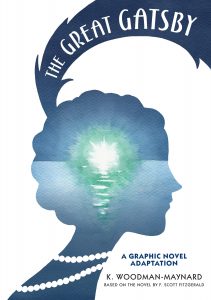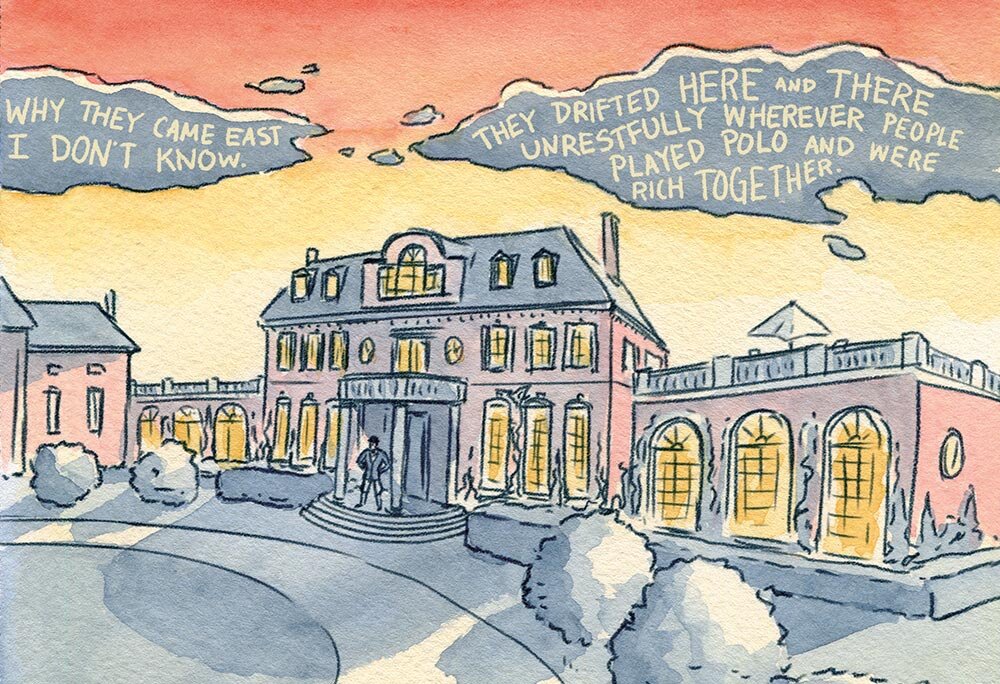Hayley and Betsy discuss the excellent, new graphic novel adaptation of The Great Gatsby adapted by K. Woodman-Maynard (Candlewick, 2021).
First Impressions of The Great Gatsby Graphic Novel by K. Woodman-Maynard

Betsy: Hayley, you and I both read one of the new graphic novel adaptations of The Great Gatsby this spring. The Great Gatsby hit public domain status this year (as well as other books published in 1925), so graphic novel adaptations are fair game in terms of copyright. Incidentally, Gatsby is by no means the first classic to be turned into graphic novel style books. We’ve looked at Poe’s stories, Romeo and Juliet, the Iliad, just to name a few.
Hayley, what stood out to you the most in this updated graphic novel version?
Hayley: You know, Betsy —the first word that comes to my mind is “colors.” The illustrations were beautiful and a large reason I picked up the book. But, after reading it, I loved how the text captured the tone of literature while the illustrations showed some of the metaphors in Gatsby. Once I finished the book, I picked up and read the first chapter of The Great Gatsby and felt like I’d just been reading it, thanks to the graphic novel. That’s not something that all graphic novels do—but this edition was able to capture that literary feel while being distinct in literary form as a graphic novel.
I think one of the things I loved about reading Gatsby as a graphic novel is the way it portrays the lavish setting and the characters themselves. What did you enjoy about it? Also, I know you read another Gatbsy graphic novel adaptation. How do you think they compared?
The Great Gatsby: The Great American Graphic Novel?
Betsy: Whenever students study The Great Gatsby, often cited as one of the “great American novels,” they examine Fitzgerald’s use of language and symbolism. I loved how this version took Fitzgerald’s symbols and ran with it. The colors are certainly part of that (such as the green light on Daisy’s dock); a student who picked up this version and read it would come away with an appreciation of Fitzgerald’s work, but also a distinct impression of some of the very things that make Gatsby such a standard read.
The lavish lifestyle is rather over the top, just as it is in Fitzgerald’s original. We see the ultimate emptiness of the “American dream,” at least when that dream is the pursuit of wealth and fame. The characters jump off the page and really come alive in a way that’s obscured a bit in the original text. Did you notice that the speech bubbles have different fonts/shapes, depending on who’s speaking? It really helps a reader keep everyone straight as well as keep the flow of conversation going without being distracting. The other version I read felt much more like the straight text with illustrations. I’d describe that version as cluttered, static, and linear as opposed to the more dynamic, seamless portrayal in Woodman-Maynard’s version.
Anytime an artist creates a graphic novel from an existing text, he or she must make decisions about how to portray different elements in the book. We’re used to movie producers doing this: a character might look different than the book’s description, a scene might be left out or slotted into a different place in the timeline, and so forth. This graphic novel stayed pretty true to the book, but the author made some interesting changes. For instance, Daisy is a blonde instead of a brunette. What do you think the effects of those types of choices are? Should we get nit-picky, or does it matter?
Hayley: Ooh, I hadn’t noticed that about the speech bubbles, but now I see it, too! You know, I occasionally do get very nit-picky. I do think there’s power in how an illustration can “show” and not tell. While the written Daisy is brunette—the graphic novel Daisy’s golden hair seemed to match her character quite nicely. Like gold, Daisy is beautiful and, ultimately, unfeeling.
Unlike a movie with actors though, I know an illustrator has power over how much they show (and what color people’s hair is!). I particularly appreciated the expressions of the characters: the cool, languid beauty of the women. The hard jaw of Daisy’s husband—Gatsby’s smile.
Coming back to whether or not to get nit-picky. I think the question is, at the end of the day, is the illustrator capturing and translating the essence of the literary work they are adapting? And for this graphic novel of The Great Gatsby, I’d say K. Woodman-Maynard succeeded. What do you think?

Does The Great Gatsby Graphic Novel Work?
Betsy: I definitely think she succeeded! Some graphic novels are good adaptations, but do so much interpretation I’d want a student to read the original first. The Poe graphic novel I reviewed falls into that category. But, frankly, I’d just as soon assign this Gatsby graphic novel in place of the “real thing,” depending on what I’d want my students to do. If we’re going for exposure to one of the most influential titles in American literature, this would serve nicely. If your goal is to teach literary analysis, then perhaps you’d want to stick with the original.
Hayley: Do you know, I do have a confession—while I studied the themes of Great Gatsby in high school and read some short stories by Fitzgerald, *gasp* I haven’t read The Great Gatsby. . . But reading this graphic novel and then picking up the book itself to read the first chapter—I felt like I’d gotten a nice dose of it. Granted, not the meat and bones of literary analysis. But still—I walked away with a deeper understand of Gatsby, the story, and the characters, plus a nice dose of the melancholy as the American dream is stripped bare. (That boat picture at the end was so depressing as he talks about the current of life!)
Thankfully, we know there is real Hope at the end of the day, but The Great Gatsby illustrates well the folly of looking to wealth, love, and even success for meaning.
Related Reading From Redeemed Reader:
- A Series: Our Newbery Buzz Series includes lots of book discussions just like this one!
- A Resource: Recommended Graphic Novels: A Book List
- A Reflection: Are Graphic Novels Literature?
We are participants in the Amazon LLC affiliate program; purchases you make through affiliate links like the one below may earn us a commission. Read more here.
Support our writers and help keep Redeemed Reader ad-free by joining the Redeemed Reader Fellowship.
Stay Up to Date!
Get the information you need to make wise choices about books for your children and teens.
Our weekly newsletter includes our latest reviews, related links from around the web, a featured book list, book trivia, and more. We never sell your information. You may unsubscribe at any time.
We'd love to hear from you!
Our comments are now limited to our members (both Silver and Golden Key). Members, you just need to log in with your normal log-in credentials!
Not a member yet? You can join the Silver Key ($2.99/month) for a free 2-week trial. Cancel at any time. Find out more about membership here.
2 Comments
Leave a Comment
You must be logged in to post a comment.


Grateful to you for reviewing this! Perfect timing for me as I plan books for next year. Blessings to you!
[…] Hayley and Betsy discuss the excellent, new graphic novel adaptation of The Great Gatsby adapted by K. Woodman-Maynard (Candlewick, 2021).Read more […]